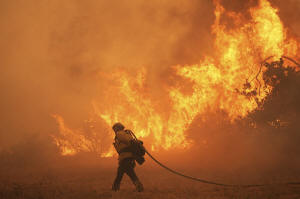Scientists give harsh grades to Trump administration work aimed at
undoing a key climate finding
[August 27, 2025]
By SETH BORENSTEIN and MICHAEL PHILLIS
WASHINGTON (AP) — Two key documents from the Trump administration aimed
at revoking the long-standing finding that climate change is dangerous
were filled with errors, bias and distortions, according to dozens of
scientists surveyed by The Associated Press.
One of the reports argues that sea ice decline in the Arctic has been
small, but uses data from the Antarctic to make the point. It uses a
French-focused study on climate-related crop losses for a claim about
the U.S. — a generalization the author said didn’t work because of
significant differences in climate and agriculture. And after saying
decades-old wildfire statistics aren’t reliable, the report reproduces
them in a graphic anyway, making it appear fires were worse a century
ago than they have been more recently.
Scientists noted those basic errors, but the most common critique from
the vast majority of the 64 who answered AP’s questions was that the
Environmental Protection Agency and the Department of Energy ignored,
twisted or cherry-picked information to manufacture doubt about the
severity and threat of climate change.
Jennifer Marlon, director of data science at the Yale Program on Climate
Change Communication, was among those.
“The work and conclusions appear biased. The data and graphs use classic
mis- and disinformation techniques,” she said. “It is almost a user’s
guide on how to lie with figures.”

The Trump administration in July proposed revoking a 2009 government
finding that climate change is a threat to public health and welfare, a
concept known as the "endangerment" finding that is backed by mainstream
science. Overturning it could pave the way for cutting a range of rules
that limit pollution from cars, power plants and other sources.
One of the Trump administration reports, by the Department of Energy,
suggests climate models used by scientists to predict warming have
overreached, that long-term trends for disasters generally don’t show
much change and that climate has little impact on the economy. The DOE
document also said there are advantages to a world with more carbon,
like increased plant growth.
AP reached out to some 350 scientists by email — nearly all the lead
authors of research cited in the Trump administration's work, plus
another 139 climate experts in science, health and economics who are
prominent in the field. Fifty-three of the 64 scientists who responded —
including outside researchers not mentioned by the reports — gave the
EPA and DOE documents a negative review. Seven praised them. The
remaining four took no clear position.
In 15 cases, scientists whose work was cited said it was misused,
misinterpreted or taken out of context.
When EPA was asked to respond to the scientists' critiques, the agency
said it had considered a variety of sources and information in assessing
whether the predictions and assumptions baked into the 2009 finding that
climate change is a public threat are “accurate and consistent.” The
Energy Department said it was committed to “a more thoughtful and
science-based conversation.”
White House spokesperson Taylor Rogers said the Trump administration “is
producing Gold Standard Science research driven by verifiable data” and
that the endangerment finding had long been misused to justify expensive
regulations “that have jeopardized our economic and national security.”
The public has until Sept. 2 to comment on the Energy Department report
and until Sept. 22 for the EPA’s proposal to revoke the endangerment
finding. Then the Trump administration must consider that feedback
before a final decision.

Overturning the finding could undermine environmental standards such as
a rule that requires reducing emissions from some coal-fired power
plants by 90%, or one limiting methane releases from the heaviest
polluting oil and gas wells. Another regulation at stake is a
requirement that new car emissions be cut roughly in half by the 2032
model year.
Environmental groups are already challenging the documents in court.
The Trump administration argues that climate science is alarmist
The EPA's report arguing to overturn the endangerment finding relied
heavily on the Energy Department's work. That DOE report is what most
scientists surveyed by the AP focused on. Together, the two Trump
administration documents maintain that while climate change is real, its
future effects are unclear and likely weaker than projected by many
mainstream scientists. The administration also contends that U.S. cuts
in greenhouse gas emissions, which largely come from burning fuels like
oil and coal, would mean little globally. The U.S. is the world's
second-largest emitter behind China.
Marlon, the Yale researcher, singled out the flawed wildfire data and
said the proper thing for scientists to do is not to show such
information. “The report instead plots this unreliable data,” she said.
The document also erroneously claimed that the area burned by wildfire
in the U.S. hadn't increased since 2007. Marlon ran the data herself to
confirm that it had, though more slowly than in prior years. Data from
the National Interagency Fire Center shows that the 10-year average
annual burn rate was 6.5 million acres in 2007; in 2024, it was almost
7.6 million acres.
When discussing sea ice, the Trump reports refer to the wrong part of
the world.
“Arctic sea ice extent has declined by about 5% since 1980,” the Energy
Department report said. But the report linked to a National Snow and Ice
Data Center chart for the Southern Hemisphere, which means Antarctica.
Antarctic sea ice has in fact declined about 5% in that time, but Arctic
sea ice shrank by more than 40%.
“It suggests sloppy work,” said data center senior scientist Walt Meier.

Report authors respond to criticism
That error and any others that are found will be corrected, the report
authors said.
“The report’s preface states clearly that it is not meant to be a
comprehensive review of climate science but rather is focused on
important data and topics that have been underreported or overlooked in
media and political discussions,” the DOE report's authors said in a
joint statement provided by co-author Ross McKitrick, a professor at the
University of Guelph in Canada specializing in environmental economics.
“Generic accusations of bias or cherry-picking are not helpful for
serious scientific discussions,” they said.

[to top of second column]
|

A firefighter battles the Canyon Fire on Aug. 7, 2025, in Hasley
Canyon, Calif. (AP Photo/Marcio Jose Sanchez, File)

The EPA’s report drew heavily on the Energy Department document for its
science, citing it twice as often as it cited the United Nations’
Intergovernmental Panel on Climate Change, which has hundreds of
scientists and editors that produce a massive document written over
several years and was a key source for the 2009 endangerment finding.
The Energy Department document was begun in March and published in July.
Its preface says the aim is to “include evidence and perspectives that
challenge the mainstream consensus.”
Pat Parenteau, an environmental law expert and former director of the
Environmental Law School at Vermont Law & Graduate School, said agencies
are required to make a “reasoned analysis” when they reverse a policy
like the endangerment finding.
“Reasoned means objective. I don’t know how it could mean anything else
other than that,” he said, adding that he didn't believe the Trump
administration reports were objective.
The National Academy of Sciences, a collection of private, nonprofit
institutions set up to provide independent and objective analysis for
policymakers, says it's preparing a fast-tracked special report on the
latest evidence on whether greenhouse gas emissions endanger public
health.
Many experts said the reports were biased
Nineteen scientists used variations of the phrase “cherry pick” to
describe the administration's reports.
“I will surely not be alone in saying these reports cherry-pick
information to minimize the threat of climate change,” said Steven
Sherwood, a professor and climate researcher at the University of New
South Wales. He said the reports were well written and easy to
understand, then added: “But being biased in selecting what to show,
they are not honest efforts to portray the broader picture, but instead
read as efforts to persuade against concern about carbon emissions.”

Francois Bareille, a French economist whose work was referenced in the
Energy Department’s report, said the work was fundamentally flawed.
“These documents do not reflect genuine scientific rigor, but rather a
misleading reinterpretation of peer-reviewed research.”
Bareille said the Energy report misused his research on French
agriculture, which concluded that previous research on climate-related
crop losses was overly pessimistic. Bareille said his findings “cannot
be generalized to other regions, such as the U.S., where both climate
conditions and agricultural systems differ significantly.”
One portion of the Energy report argued that ocean acidification should
more accurately be called “ocean neutralization.” The authors reasoned
that ocean life “appear to be resilient” to such changes.
Ocean acidification happens as waters absorb rising carbon dioxide,
which damages marine life with shells, such as coral, oysters and
mollusks. That harm risks disrupting food webs.
Stony Brook University's Stephen Schwartz, former chief scientist of the
Department of Energy’s Atmospheric Science Program, said using a more
benign term such as “neutralization” would be “ludicrous.” And Waleed
Abdalati, who served as NASA chief scientist during the Obama
administration, said: “The simple fact is that carbon dioxide is making
the oceans more acidic, which carries harmful effects.”
Tim Gallaudet, chief of the National Oceanic and Atmospheric
Administration during the first Trump administration, praised the recent
administration reports and singled out the issue of ocean acidification.
He agreed with the word “neutralization” and said recent studies have
shown smaller or nonexistent harms when compared with previous science.
One economics expert cited in the report praised it, saying it departed
from unnecessarily alarmist findings of other national and international
climate assessments.
“The problem is that mainstream ‘climate science’ is pretty worthless.
Hopelessly politicized, mired in groupthink and virtue signaling,” said
James Davidson, a professor at the University of Exeter. His work was
cited to dispute the mainstream scientific finding that rising carbon
dioxide levels in the past drove warming.

Davidson said the Department of Energy’s authors are skeptical of the
current consensus and hold beliefs that previously would have been
ignored.
“In other words, they and the so-called 'mainstream’ have changed places
for the moment,” he said.
Scientists grade the reports from A to F
Asked to grade the administration documents as if they were produced by
undergraduates, 19 of the 42 scientists who responded to that question
assigned the work an F, for failing. The reports earned five As along
with an A-minus. Some criticized the question as silly or ridiculous,
with one saying it suggests “your goal here is not journalism but team
sport.”
“I would give them both a D on truth and an A on deviousness,” wrote
climate scientist Jennifer Francis of the Woodwell Climate Research
Center. She said the analysis was twisted to support the desired
narrative.
“The EPA report gets an ‘R’ for ridiculous,” she said.
The DOE report argues that worst-case climate models often used by
scientists to describe the consequences of doing nothing to reduce
emissions exaggerate how much the world has already warmed and how much
more it will heat up.
In that section, the Energy Department report cited climate scientist
Zeke Hausfather four times, including a graphic of his.
Hausfather wrote in a blog that the report used one less important
figure “to reinforce the point they were trying to make, and never
actually referred to the broader conclusion of the paper that old models
had by-and-large performed quite well,” Hausfather wrote. “The actual
content of my paper went counter to the narrative they were trying to
present, and thus was ignored.”
He added: “That's why I’ve publicly called this process a farce.”
When asked to respond, a DOE spokesperson encouraged Hausfather to
submit his concerns as part of the public comment process.
___
Data journalist M.K. Wildeman contributed to this story.
All contents © copyright 2025 Associated Press. All rights reserved |